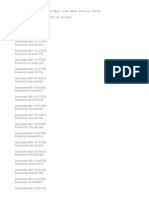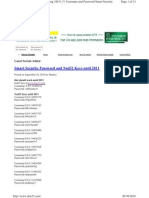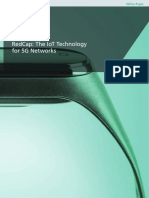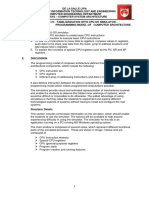Advanced Programming Lab 1
Uploaded by
Miranda LiAdvanced Programming Lab 1
Uploaded by
Miranda LiCOMS W3157 Advanced Programming, Lab #1
(100 points total)
--------------------------------------------------------------------------Please read this assignment carefully and follow the instructions
EXACTLY.
Submission
----------Please refer to the lab retrieval and submission instruction, which outlines
the only way to submit your lab assignments. Please do not email me your
code.
If a lab assignment consists of multiple parts, your code for each part must
be in a subdirectory (named "part1", "part2", etc.)
Please include README.txt in the top level directory.
README.txt should contain the following info:
-
At a minimum,
your name
your UNI
lab assignment number
description of your solution
The description can be as short as "My code works exactly as specified in
the lab." You may also want to include anything else you would like to
communicate to the grader such as extra functionalities you implemented or
how you tried to fix your non-working code.
Makefile
--------If a part asks for a program, you must provide a Makefile. The TAs will
make no attempt to compile your program other than typing "make".
The sample Makefile in the lecture note is a good starting point for the
Makefile you need to write for this lab. If you understand everything about
the sample Makefile, you should have no problem writing this labs Makefile.
Here are some additional documentations on Make:
- Stanford CS Education Library has a nice short tutorial on
Makefiles. See Unix Programming Tools, Section 2, available at
http://cslibrary.stanford.edu/107/.
- The manual for make is available at
http://www.gnu.org/software/make/manual/make.html. Reading the
first couple of chapters should be sufficient for basic
understanding.
There are a few rules that we will follow when writing makefiles in
this class:
- Always provide a "clean" target to remove the intermediate and
executable files.
- Compile with gcc rather than cc.
- Use "-Wall" option for all compilations.
- Use "-g" option for compiling and linking.
The sample Makefile follows all these rules.
Part 1 (50 points)
-----------------Write a C program that reads 2 positive integers from the user, and
prints:
- the average of the two (this should be printed as a floating point
number.)
- whether each number is a prime number or not
- whether the two numbers are relatively prime or not (see
http://en.wikipedia.org/wiki/Coprime if you dont know what this
means.)
You can assume that the user will input only positive integers, i.e.,
dont do any error checking.
In order to see if two numbers are relatively prime, you should
calculate the GCD using Euclidean algorithm. You are allowed to look
up the algorithm and/or code on the Internet, in which case you should
cite the source in your README.txt file.
Your code should be organized as follows:
- gcd.h & gcd.c: GCD calculation function header and definition
- prime.h & prime.c: prime number testing function header and
definition
- main.c: everything else
- Makefile
All files must be named EXACTLY as above, case-sensitive.
"make", it should build an executable file called "main".
When you run
The makefile should have correct dependencies. For example, if you
build everything, change prime.h, and run make again, only prime.c and
main.c should recompile, not gcd.c. (You can simulate changing a file
by using touch command.)
You can use
printf("You typed in %d and %d\n", x, y);
to print integers, and
printf("The average is: %f\n", avg);
to print a floating point number.
And you can use
scanf("%d", &x);
to read an integer that the user types in.
in front of the variable.
Dont forget the ampersand
Part 2 (50 points)
-----------------Write a C program called "convert" that reads a signed decimal integer from
the user and prints the number in 4 different ways: signed decimal, unsigned
decimal, hexadecimal, and binary.
Here are a few example runs of the program:
$ ./convert
-1
signed dec:
unsigned dec:
hex:
binary:
-1
4294967295
ffffffff
1111 1111 1111 1111 1111 1111 1111 1111
$ ./convert
256
signed dec:
unsigned dec:
hex:
binary:
256
256
100
0000 0000 0000 0000 0000 0001 0000 0000
There is a bash shell trick that you might find useful for testing your
program. You can evaluate an arithmetic expression like this:
$ echo $(( 1 + 2 + 3 ))
6
In addition, you can take the output of one program, and feed it as a user
input to another program by chaining the two programs with | character.
So, you can input the minimum 32-bit integer like this:
$ echo $(( -2
signed dec:
unsigned dec:
hex:
binary:
* 1024 * 1024 * 1024 )) | ./convert
-2147483648
2147483648
80000000
1000 0000 0000 0000 0000 0000 0000 0000
Note that your program must behave EXACTLY the same as the sample runs shown
above. Given the same number, your program must generate the EXACT same
output--same order, same strings, same spacing.
To help you get started, I gave you a little C program called printf-test.c
in the lab 1 skeleton code. Please take a look at it. Good luck!
You might also like
- Most Common Interview Questions and Answers93% (28)Most Common Interview Questions and Answers3 pages
- 50 Most Common Interview Questions and Answers95% (43)50 Most Common Interview Questions and Answers40 pages
- LETTER ASKING FOR FINANCIAL ASSISTANCE IN PAYING HOSPITAL BILLS (For Scribd)81% (79)LETTER ASKING FOR FINANCIAL ASSISTANCE IN PAYING HOSPITAL BILLS (For Scribd)2 pages
- How To Piss Off A Narcissist Without Even Trying - An Upturned Soul PDF60% (5)How To Piss Off A Narcissist Without Even Trying - An Upturned Soul PDF20 pages
- "Headhunter" Hiring Secrets: The Rules of The Hiring Game Have Changed - . - Forever! by Skip Freeman88% (8)"Headhunter" Hiring Secrets: The Rules of The Hiring Game Have Changed - . - Forever! by Skip Freeman346 pages
- Samsung Sync Master 226bw 206bw Service ManualNo ratings yetSamsung Sync Master 226bw 206bw Service Manual79 pages
- Data Types, Operators, and Expressions: For Multiple-Choice and Essay QuestionsNo ratings yetData Types, Operators, and Expressions: For Multiple-Choice and Essay Questions6 pages
- Introduction To Programming ETCS-108: Practical File)No ratings yetIntroduction To Programming ETCS-108: Practical File)55 pages
- 23ES1113_PIC_LABORATORY_ALGORITHM_ALONENo ratings yet23ES1113_PIC_LABORATORY_ALGORITHM_ALONE21 pages
- CO222 Lab 01 - Introduction to C ProgrammingNo ratings yetCO222 Lab 01 - Introduction to C Programming3 pages
- Write A C Program That Receives 10 Float Numbers From The Console and Sort Them in Nonascending Order, and Prints The ResultNo ratings yetWrite A C Program That Receives 10 Float Numbers From The Console and Sort Them in Nonascending Order, and Prints The Result36 pages
- Assignment 1 - Fixing and Writing Simple ProgramsNo ratings yetAssignment 1 - Fixing and Writing Simple Programs3 pages
- 159.101 Computer Science Fundamentals - Massey - Exam - S1 2017No ratings yet159.101 Computer Science Fundamentals - Massey - Exam - S1 20175 pages
- UNIX Shell Programming Interview Questions You'll Most Likely Be AskedFrom EverandUNIX Shell Programming Interview Questions You'll Most Likely Be AskedNo ratings yet
- Python Advanced Programming: The Guide to Learn Python Programming. Reference with Exercises and Samples About Dynamical Programming, Multithreading, Multiprocessing, Debugging, Testing and MoreFrom EverandPython Advanced Programming: The Guide to Learn Python Programming. Reference with Exercises and Samples About Dynamical Programming, Multithreading, Multiprocessing, Debugging, Testing and MoreNo ratings yet
- Thoughts and Feelings, 4th Edition - Sample Worksheets93% (30)Thoughts and Feelings, 4th Edition - Sample Worksheets11 pages
- Dos and Donts To Protect The Interest of Jobseekers100% (2)Dos and Donts To Protect The Interest of Jobseekers4 pages
- How To Get A Background Check and Credit Report On Anyone 201567% (6)How To Get A Background Check and Credit Report On Anyone 20153 pages
- C - CURE BMS SV ApplicationExplorer enNo ratings yetC - CURE BMS SV ApplicationExplorer en1,382 pages
- Interfacing Esp8266 With Openweathermap Api For Real-Time Weather MonitoringNo ratings yetInterfacing Esp8266 With Openweathermap Api For Real-Time Weather Monitoring5 pages
- Restore or import database to a new computer - Initial setup - eM ClientNo ratings yetRestore or import database to a new computer - Initial setup - eM Client7 pages
- Object Oriented Software Engineering Using UML Patterns and Java 3rd Edition by Bernd Bruegge, Allen H Dutoit ISBN 0133002098 9780133002096pdf download100% (3)Object Oriented Software Engineering Using UML Patterns and Java 3rd Edition by Bernd Bruegge, Allen H Dutoit ISBN 0133002098 9780133002096pdf download90 pages
- 7eleven Case Study: Assignment QuestionsNo ratings yet7eleven Case Study: Assignment Questions3 pages
- Redcap: The Iot Technology For 5G NetworksNo ratings yetRedcap: The Iot Technology For 5G Networks3 pages
- Gap Assessment in The Emergency Response Community: PNNL-19782No ratings yetGap Assessment in The Emergency Response Community: PNNL-1978248 pages
- Full download (eBook PDF) Calculus Early Transcendentals, 2nd Global Edition pdf docx100% (7)Full download (eBook PDF) Calculus Early Transcendentals, 2nd Global Edition pdf docx46 pages
- (Lecture Notes in Educational Technology) Deepanjali Mishra, Yuangshan Chuang - Learning How To Learn Using Multimedia-Springer (2021)100% (3)(Lecture Notes in Educational Technology) Deepanjali Mishra, Yuangshan Chuang - Learning How To Learn Using Multimedia-Springer (2021)199 pages
- Top 10 SMD Resistor Manufacturers in The WorldNo ratings yetTop 10 SMD Resistor Manufacturers in The World8 pages
- Class XII - IP - QP - PRE TERM1 - PB2 - 2021 (SET B)No ratings yetClass XII - IP - QP - PRE TERM1 - PB2 - 2021 (SET B)12 pages























































































































